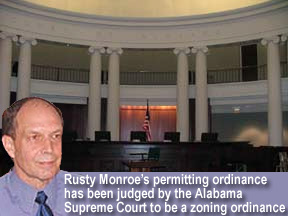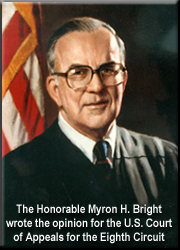|
Alabama and California rulings could impact regulation of cell towers nationwide
March 16, 2007 - Two cases have recently been decided that should have a positive impact on industry siting battles in the country. The first, an Alabama case decided last Friday by the Alabama Supreme Court; the second is a Federal lawsuit from California that was affirmed by the Ninth Circuit Court of Appeals on March 13.
The Alabama Supreme Court affirmed a lower court decision holding that a local ordinance, patterned after one provided by the Center for Municipal Solutions, and promoted throughout the nation by CMS's founders, Lawrence (Rusty) Monroe and Dick Comi, is a zoning ordinance and not a permitting ordinance. This is significant, siting attorneys say, in that zoning ordinances cannot be enforced in the police jurisdictions, an area comprised of one to three miles outside of the city limits, while permitting ordinances can be imposed in the PJ.
Monroe and Comi have consistently argued that this ordinance is a permitting ordinance, thereby allowing their municipal clients to require carriers to file applications and pay fees associated with both new towers and collocations within the PJ.
The municipal advocates say their philosophy is to protect and to provide the community with a means and mechanism to be proactive so that the community makes its own choices and controls its own destiny to the extent allowable under law. Some opponents say it is designed to be a revenue source for the municipality.
Siting issue started in Selma
In the case released on Friday, the City of Selma, AL sued Dallas County claiming a tower built by the county at the county courthouse violated the local tower ordinance, as prepared by CMS, and a local historic district ordinance, in that the county did not file applications under either ordinance claiming that it is exempt from city zoning ordinances. The court decided that the tower is being used for "governmental" purposes, therefore, it held in favor of the county that the placement of the tower is exempt from local ordinances.
In the decision, the court noted that the trial court ruled that both ordinances were zoning ordinances. The City of Selma did not argue against that holding on appeal. Therefore, since the Supreme Court affirmed the lower court's ruling, that decision should stand.
California decision could be argued in other circuits
The Ninth Circuit Court of Appeals ruled Tuesday that the County of San Diego Wireless Telecommunications Ordinance violates Section 253 of the Telecommunications Act of 1996 (TCA). The zoning ordinance is an impermissible barrier to entry which prohibits or may prohibit the provision of wireless telecommunications services.
Sprint had sued the County of San Diego bringing a facial challenge to the ordinance. The USDC for the Southern District of California ruled that the long cumbersome approval process and the broad discretion granted to San Diego city officials to approve or deny wireless applications violated the TCA. The District Court enjoined the enforcement of the ordinance. Both the County and Sprint appealed to the Ninth Circuit. San Diego County appealed the ruling that the ordinance violated the TCA. Sprint appealed from the ruling that it was not entitled to 1983 damages (a charge that was dismissed due to an earlier US Supreme Court ruling).
The county's regulations had allowed the governing body to dictate where wireless carriers could or couldn't install antennas and imposed an onerous application process. The court ultimately concluded that the county's ordinance "imposes a permitting structure and design requirements that presents barriers to wireless telecommunications within the county, and is therefore preempted by section 253(a)."
In light of historic patterns in many localities of delaying denials or approvals of applications, sometimes for years, this is seen as a big victory for wireless carriers. The decision affirms that they can preemptively sue to enjoin the enforcement of local government wireless zoning ordinances that violate the Telecommunications Act of 1996. While this case is limited as controlling precedent to the Ninth Circuit, the decision is an important national decision that could be argued in other circuits.
Local governments, including the County of San Diego, had previously argued that carriers had to wait for municipalities to reject land use applications and then appeal each application to courts individually.
There has been no word as to whether San Diego County will continue its appeal to the US Supreme Court.
N. Andrew Rotenstreich of Haskell Slaughter Young & Rediker, LLC and Tim Sullivan, in-house counsel at T-Mobile contributed to this report.
|